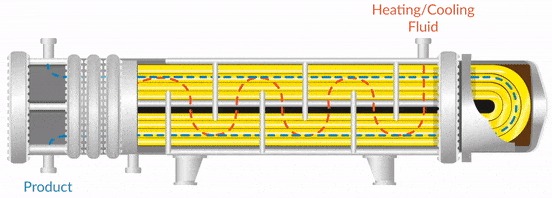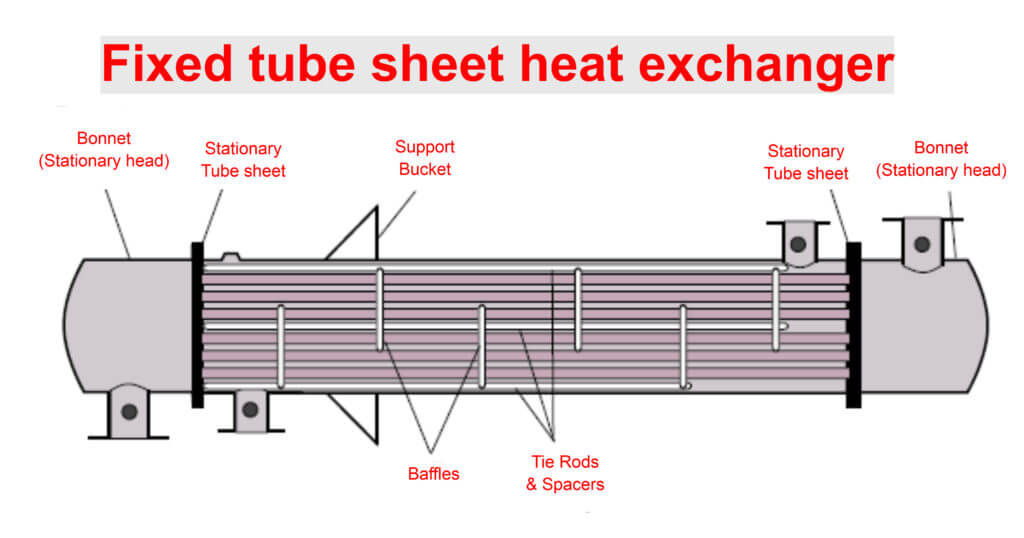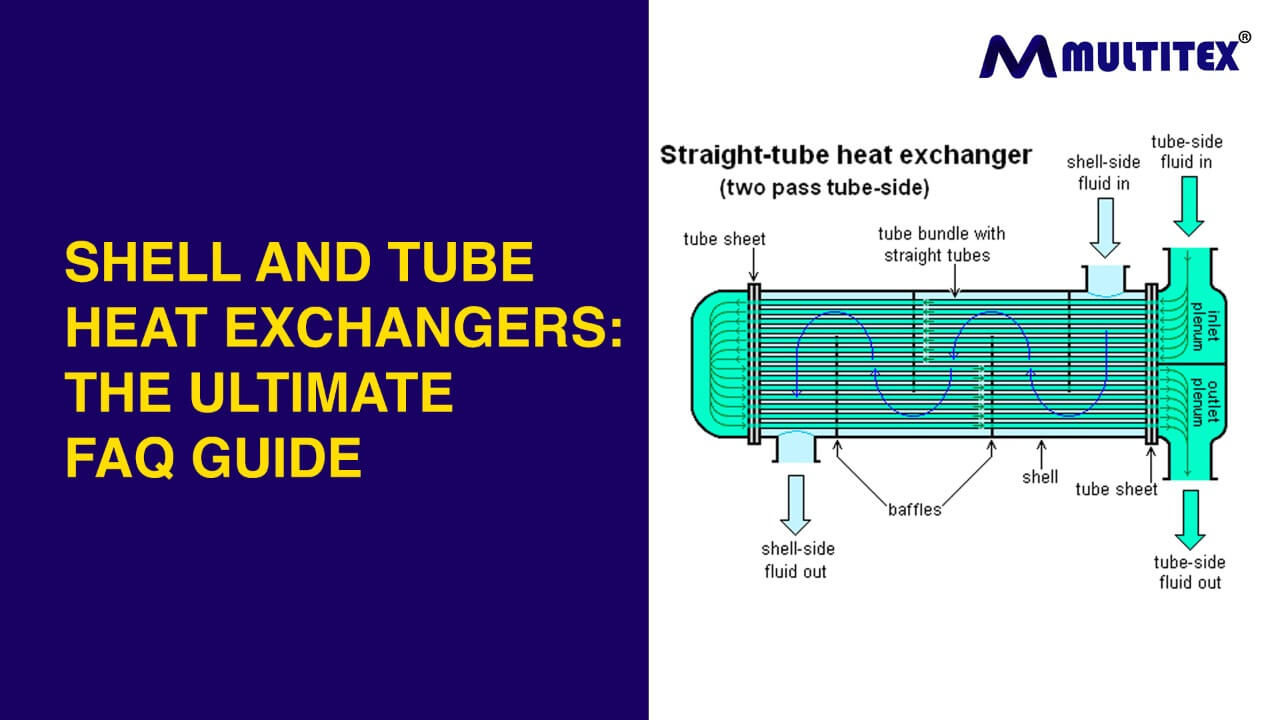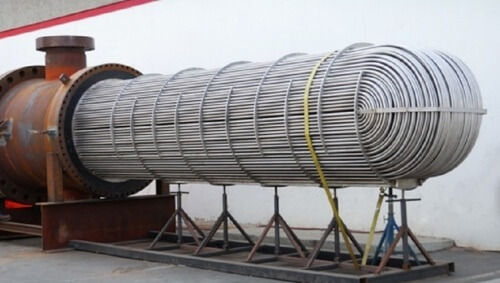Shell and tube heat exchangers – what are these, and how do they work?
Shell and tube heat exchangers are equipment used in transferring energy from a liquid in one shell to liquids, solids, or gases present in another shell. These function very similarly to regular heat exchangers.
The idea behind these exchangers is simple. Where there are two substances (one hot and one cold) placed next to one another, energy is transferred from the hotter substance to the colder substance. In these heat exchangers, two substances are placed in thermals very close to one another. As these substances move inside the thermals, heat transfer happens. The hot liquid may pass through multiple times inside the tubes until the desired level of heat transfer has occurred.

Where all are shell and tube heat exchangers used?
Shell and tube heat exchangers are commonly used in the below applications.
- Coolers
- Boilers and reboilers
- Process heaters
- Condensers
Major components of a shell and tube heat exchanger
The significant parts of a shell and tube heat exchanger are:
Shell
The shell is the outer casing that holds all the other parts together. It also contains the process liquid.
Ports
The ports are connections where fluids can flow in and flow out. There are four connection ports in total – tube side in, tube side out, shell side in, and shell side out.
Baffles
Baffles are the critical components of any shell and tube heat exchanger. These are physical barriers that control the volume of liquid that flows in and create disturbances that can reduce the concentrations of liquids that flow. Thus, baffles, present at the right place, can improve the efficiency of the heat exchanger.
Turbulator
A turbulator is a part that is inserted into the tubes to create a turbulent flow. As a result, there is nil or minimal sediment processing and fouling. A turbulator can also help in improving the level of energy transfer.
Inlet/outlet connections
These are open connections through which substances flow in and out.
Enhanced surface tube
There are multiple individual tubes that are bundled together through which fluids travel from one end to another. These are called surface tubes. The material, quality, and size of these tubes play vital roles in determining the efficiency of these shell and tube heat exchangers.
Tubes with single or two-phases
These heat exchangers may have tubes with single or two phases. In an exchanger with a single-phase tube, when a liquid enters the device, it is sent out in a liquid stage. In a two-phase tube, a stage change happens. Here, heat may enter the tube and leave as a liquid.
Favorable properties of shell and tube heat exchangers
You have to make sure that the shell and tube heat exchangers that you choose come with the below properties.
- Ability to handle high temperature and high-pressure situations
- Comes with a strong and capable outer case
- Customizable into different sizes, capacities, and orientations
- Comes with parts that can be easily cleaned and serviced
Common shell and tube heat exchangers designs and types
Shell and tube heat exchangers have standard designs, thanks to some of their consistent features. There are two ways any tube heat exchange manufacturer will design the product.
- Thermal Design – This includes designing the thermal aspects of the exchanger using computer programs. This design will help set values like pressure drops, tube size, and heat transfer coefficients precisely.
- Mechanical Design – Here, mechanical designs like the size and thickness of the shell and the flange thickness are measured. This helps decide the physical strength and capabilities of these exchangers.
When it comes to shell and tube exchanger types, three models are approved by the Tubular Exchangers Manufacturers Association (TEMA).
- U-Tube – These are shells with tubes that bend into a U-shape. A single tube plate connects all these U-tubes together. The bends are designed to slightly expand and constrict when hot fluid passes through slightly. The bent tube sheets are free-floating and not connected to the shell.
Advantages of U-tube sheets
- Cost of installation is low
- A single tube sheet is enough
- Tube bundle can be removed and cleaned
- Minimal by-passing of shell side fluid
Fixed tube sheet – These are shells with fixed tubes that run parallel to one another. These are connected to two tube plates on either side. The tubes are blocked strategically by one or more baffles. Such types are easy to manufacture and maintain too.

Image Credit: chemicalengineeringworld.com
Floating head heat exchangers – These combine the designs of both the U-tube and fixed tube designs. Here, one half of the tubes are bent and free-floating, while the other half resembles the fixed tubes and are connected to tube plates and the shell.
Advantages of floating head heat exchangers:
- Mechanical cleaning is easy
- Individual tubes can be replaced as and when needed
- You can have as many tube side passes as you want
- Perfect for use in high temperature, high-pressure settings
There are two major types you should know of when it comes to connections on the shell side.
- Threaded connection – Threaded connections use grooves and rims, and you just need to screw the parts together. This is easier to assemble and disassemble too.
- Flange connection – Here, different parts are connected using lips with gaskets. The gaskets make the connections air-tight. Flange connections can work with pipes of so many sizes and are perfect when you cannot risk leakages.
Factors to consider when buying a shell and tube heat exchanger
You may be using shell and tube heat exchangers for different purposes. Whatever purpose the heat exchanger may be used for, here are some common factors to consider before choosing the right one.
- Material – The shell and tube material will decide how powerful and withstanding the exchanger will be.
- Scalability – Does the exchanger work equally well with low and high load heat transfers? Can it be used when you scale up your operations? Check these details before you order one.
- Operational specifications – Shell and tube heat exchangers are built to handle specific maximum temperatures and pressures. Make sure these operational specifications match your process needs.
- Sustainability – How energy efficient is the device? Does the manufacturer take into account environmentally friendly factors? Such a heat exchanger will increase your carbon footprint. Choose models that are energy efficient and relatively safer for the environment.
Common materials used to make shell and tube heat exchangers
There are two major parts of shell and tube heat exchangers – the shell and the tube. You need to choose suitable materials for both to design an efficient system.
Common shell materials
- Brass
- Copper
- Stainless steel
Common tube materials
- Copper
- Stainless steel
While copper is more expensive than stainless steel, the thermal conductivity of copper is up to 20 times more than that of stainless steel. This means that copper can transfer heat about 20 times faster than stainless steel, which is a massive advantage for industries that need to improve process speed. However, when it comes to durability, stainless steel is more rust and corrosion-resistant than copper.
Liquids and cooling fluid options used in shell and tube heat exchangers operation
Some of the common liquids that these heat exchangers use for operation are:
- Deionized water
- Saltwater
- Motor oil
- Steam
- Hydraulic oil
When it comes to cooling fluid options that can be used in shell and tube heat exchangers, you can choose between the following.
- Water – Cheaper, easier to store and use, and has good sufficient thermal qualities.
- Propylene Glycol – Less toxic mixture with high boiling and low freezing points.
- Ethylene Glycol – Slightly more toxic than propylene glycol. This also has high boiling and low freezing points.
What are the Maximum Pressure and temperatures of the Shell side of the Heat Exchanger?
When it comes to maximum pressure accommodations of the shell side of the heat exchanger, the values totally depend on the type of materials used for constructing the shell. The maximum pressure can range anywhere from 100 PSI to 1000 PSI.
When it comes to the maximum temperature, the design temperatures can vary between -250 degrees Celsius and 800 degrees Celsius. It is beneficial to invest in a shell and tube heat exchanger that has a wide temperature margin (ability to handle very high and very low temperature levels).
Different quality Standards for Shell and Tube Heat Exchangers
Do shell and tube heat exchangers need to pass quality standards? Definitely yes.
Since these exchangers are used in a variety of sensitive and intensive industrial applications, they have to meet the safety standards and quality standards of these processes. Here are some of the quality standards that these heat exchangers need to satisfry.
- IS 4503-1967
The Indian Standards 4503 is the Indian quality standard for shell and tube heat exchangers. This standard will include specification details like the below.
- General design
- Design pressure
- Design stress
- Material used
- Type of shell, baffle, and tubes
2. ASME
This is a set of safety standards and codes set by the American Society of Mechanical Engineers (ASME). There are more than 500 standards and associated products that come under ASME’s guidelines.
Shell and tube heat exchangers need to satisfy ASMEs standard boiler code and pressure vessel code for excessive pressurization.
3. TEMA
The Tubular Exchanger Manufacturers Association (TEMA) is an association especially for shell and tube heat exchangers. This association puts up three standards based on the type of exchanger constructed.
- Class R – For large scale operations that require intensive features like in the petroleum industry
- Class C – For general commercial applications
- Class B – For chemical process services
4. CRN
The Canadian Registration Number (CRN) standards are used to design different pressure vehicles, piping systems, heat exchangers, and other piping systems. If you buy a shell and tube heat exchanger and use it anywhere in Canada, the device must satisfy CRN standards.
What are the advantages and disadvantages of shell and tube heat exchangers?
| Advantages | Disadvantages |
| It can be customized into different sizes | Cleaning can be slightly challenging when the number of tubes is high |
| It is easy to dismantle and assemble the device | Bad design can lead to leakage of energy and lowered energy transfer |
| It can handle high pressures and temperatures | Shell and tube heat exchangers can be very expensive |
| Heat transfer can be enhanced using additions like heat transfer fins | |
| Capacity can be instantly improved by adding tubes |
How can you choose the best shell and tube heat exchangers?
You can choose the best shell and tube heat exchangers based on factors like the below.
- Pressure and temperature acceptability – Handling wide variations in pressure and temperature is a preferred feature to have.
- Level of maintenance – It is preferred to choose devices that offer low levels of maintenance. These devices must be designed in a way to allow easy cleaning.
- Materials used – Choose materials that are corrosion and rust-free and last for a longer time. In addition, materials that conduct energy faster are advantageous.
- Size – Choosing the right size is definitely a critical part of how effective these heat exchangers work. A very large heat exchanger may perform faster but will consume more energy. A smaller heat exchanger may be more energy efficient but will have a lower capacity and need to run continuously.
Warranty of shell and tube heat exchangers
Most of these shell and tube exchangers have a life span of 20+ years. The warranty period is usually 2-5 years, depending on the manufacturer’s terms and conditions.
Contact your manufacturer if you want to know the exact warranty details of your shell and tube heat exchanger.
Average cost of Shell side of the Heat Exchangers
The cost of these shell and tube heat exchangers may be as low as ₹25,000 and go up to several lakhs. The cost depends on the size of these exchangers, the material used, and the capacity.
Read More: The humble Heater Treater packs a big punch!!
Conclusion
Shell and tube heat exchangers are integral parts of many cooling and heating systems. They are used in applications starting from small refrigerators to really huge equipment used in the pharmaceutical and petroleum industries.
When you decide to buy one such exchanger, the investment is considerably high. Therefore, make sure you pick up models that are accredited for quality and safety and are IS4503 and ASME certified. This way, you can be sure of the performance and quality.
Multitex is equipped with a heavy manufacturing infrastructure that can be used to build intensive heat exchangers of all sizes and specifications. All these exchangers come with process and thermal guarantees. We use exceptional materials like duplex and super duplex stainless steel, and clad vessels to ensure your exchanger has a longer, problem-free life.
Our constructional experts work hand-in-hand with the clients, making sure the equipment exactly matches the needs.
We have excelled in creating innovative and practical solutions that are tailor-made to the needs of our clients for the last 50 years.
Our in-house manufacturing and engineering facilities are run by experts and are accredited by international organizations.
If you have any queries regarding shell and tube heat exchangers and how to use one in your plant or unit, get in touch with us right away. Our team will offer expert consultation and strategic solutions.

